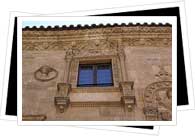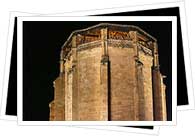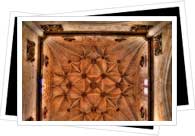Highlights:

For a mansion in which Salamanca architect Juan de Alava once lived, "Casa de las Muertes" certainly has a foreboding name! Why is it called House of the Dead? The mansion's façade features the Plateresque style and certainly doesn't appear at all morbid. However, if you focus in on the upper windows, you'll notice that at their bases there are four skulls- due to these skulls, the mansion came to be known as the "House of the Dead."
In Salamanca, which was once not only the academic but also a religious nucleus of Spain, we're sure you've noticed that there is a great deal of religious architecture. In west Salamanca, there are various religious edifices worth a visit. The two highlights, however, are the Convento de Santa Úrsula and La Purísima.
 The Convento de Santa Úrsula is a tall, plain structure located in the heart of a popular strolling area which is most recognizable by its highly unusual open-topped tower. The big draw of the convent is, however, its church, in which you'll find the magnificent marble tomb of Archbishop Alonso Fonseca which was designed by Spain's true Renaissance-man Diego de Siloé- he was a sculptor, painter, and architect!
The Convento de Santa Úrsula is a tall, plain structure located in the heart of a popular strolling area which is most recognizable by its highly unusual open-topped tower. The big draw of the convent is, however, its church, in which you'll find the magnificent marble tomb of Archbishop Alonso Fonseca which was designed by Spain's true Renaissance-man Diego de Siloé- he was a sculptor, painter, and architect!
The latter of the two, La Purísima is an Augustinian monastery situated just across from the Palacio de Monterrey- a 16th century noble palace with end towers. While you can't enter the palace, take a look and then venture through the doors of the 17th century Purísima, where you'll see not only magnificent architecture but also a huge collection of paintings by Spain's famous José de Ribera.
 Finally, the 16th century Colegio del Arzobispo Fonseca, dedicated to the archbishop whose tomb you can check out in the Convento de Santa Úrsula, was a collaborative architectural effort between many leading architects- amongst them Diego de Siloé and Juan de Alava. Built in a more sober version of the Plateresque style, be sure to head out to the awe-inspiring beauty of its two-story Renaissance cloister- it's a great way to remember the west Salamanca quarter before moving on!
Finally, the 16th century Colegio del Arzobispo Fonseca, dedicated to the archbishop whose tomb you can check out in the Convento de Santa Úrsula, was a collaborative architectural effort between many leading architects- amongst them Diego de Siloé and Juan de Alava. Built in a more sober version of the Plateresque style, be sure to head out to the awe-inspiring beauty of its two-story Renaissance cloister- it's a great way to remember the west Salamanca quarter before moving on!